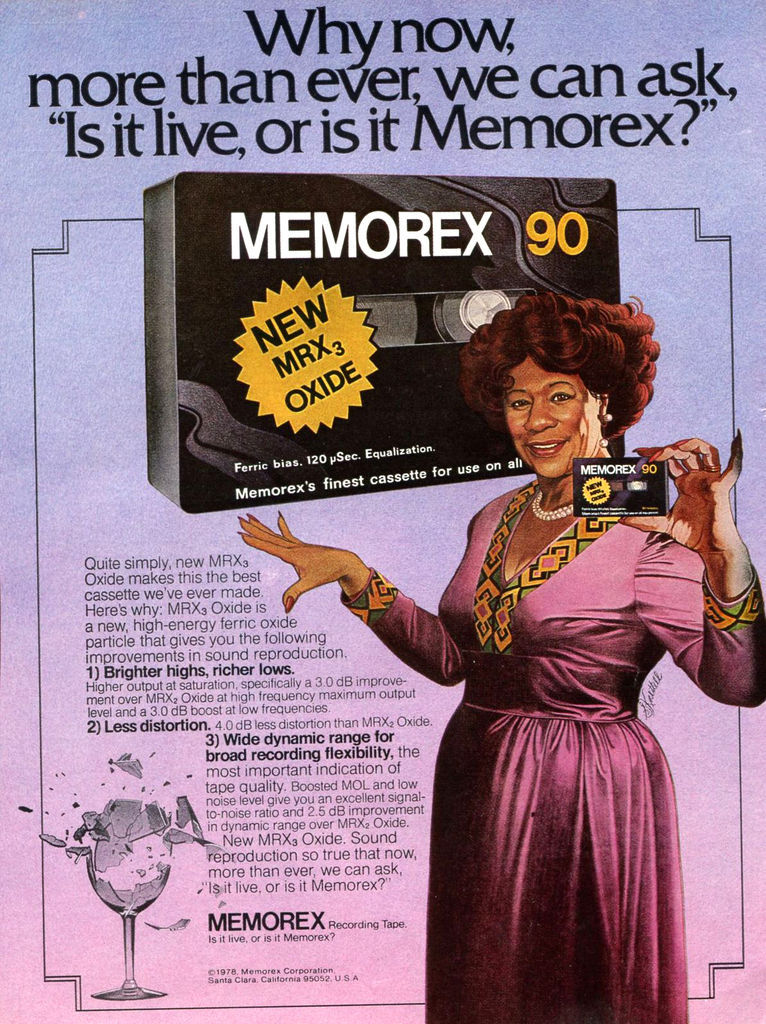Roger Skoff
Roger Skoff Writes about what you can believe in audio
Back in 1972, as part of what may have been the most famous adverting program our industry has ever known, the makers of Memorex recording tapes ran a TV commercial featuring jazz singer Ella Fitzgerald that asked the question “Is it real or is it Memorex?” The implication, of course, and whole basis of the campaign was that Memorex recording tape would so faithfully, and so clearly capture and reproduce the sound of Ella’s voice (or whatever else you might choose to record at home) that you couldn’t tell the difference between the recording and the actual live performance.
Although great advertising, it wasn’t exactly true, even today. Thus far we’ve been able to come very close to believability, at least on certain kinds of sounds, but the time when we can reproduce every aspect of a live performance – not just its full frequency range, but the timbre, dynamics and total harmonic envelope of each of its component sounds and the imaging and positioning of each sound within its acoustic environment — indistinguishably from the real thing has not yet arrived and may never come.
There are things, though, that we can do right now to make our systems sound better and to give us a better approximation of the “live” performance experience. Some are obvious: We can buy more or better stereo equipment; use rugs, wall hangings or special absorbers/diffusers to improve the acoustics of our listening rooms; or adjust the positioning of our speakers or listening chairs to just that last degree for better imaging and soundstaging. Others are less apparent and some may even seem outright unreasonable. Like, for example, using better cables to get better sound.
It’s “common sense” to believe that wires are just wires; that all they do in any stereo system – even the very best and most expensive – is just to carry signal from one place to another; and that, unless they’re broken or badly designed (in terms of resistance, capacitance, and inductance), they shouldn’t have any effect at all on the sound we hear. In fact, the “Objectivists” among us (you know who I mean – the guys who believe that what we hear doesn’t matter and that, if it can’t be proven by double-blind testing it doesn’t exist at all) dismiss cables and all sorts of other audiophile “tweaks” as nothing but “voodoo” or “snake oil”.
The fact, though, is that cables do make a very significant difference to system performance. And now I, with your help, if you’ll do as I suggest, am going to prove it to you with a really simple experiment that should only take a little time and cost little or nothing at all:
Do you have any of the “throw-away” interconnecting cables that they used to give away free when you bought certain “mid-fi” stereo components? If so, get out one pair; we’re going to use it. Otherwise, go to an appliance or mid-fi stereo store and pick up the cheapest pair of interconnects you can find.
The first thing to do with your pair of interconnects is to take some nail polish or a paint marker (be sure to use a color that will give good contrast against the color of the connectors) and make a mark on each of the RCA connectors at the same end of the two cables (the two channels). This is just to identify the ends and, as long as it’s visible, may be of any size or color you want.
Next look at the interconnects: Are they two separate cables? Or are the two cables (right and left channel) connected together to make a single two-channel cable? If it’s two separate cables, good. Otherwise, take a single-edge razor blade or an X-acto knife and carefully cut only the plastic membrane down the middle of the two cables to separate them. Be careful NOT to cut the cables, themselves, but only to cut the thin plastic part that holds them together.
Once the cables are separated, use your blade to CAREFULLY make a cut all around (circling) the cable right next to where the connector is moulded-on. The object is to cut ONLY through the plastic jacketing of the cable and NOT to cut through the braided metal shielding directly under it. (A HINT: If you cut lightly through the jacket and then sharply bend the cable at the cut, it will either tear the jacket at the cut point, exposing the shielding, or will make it easier for you to cut through the jacketing without cutting the shielding. When you are finished with each cut, it should expose the shielding so you can see it.)
Do this around all four RCA connectors
Then, turning the blade so that its cutting edge is up (to cut the jacketing) and the dull edge is down (in contact with but not cutting the cable’s shielding), insert the blade into the cut ring, pointing away from the RCA connector and cut the jacket in a straight line (a slit) running all the way from the RCA connector you started from to the RCA connector at the other end of the cable.
Do this for both cables.
You should now be able to grab the jacket at one end and gently pull it away from the cable in one piece. (IMPORTANT NOTES: 1) If the cable was made by a “tubing” process, as is normally the case, the jacket will easily come off. If it was made by a “pressure” process it may be difficult or impossible to remove, and the experiment must be re-started with a different pair of interconnects. 2) the exposed shielding will normally be braided. It may also, however, be “served” – not braided, but just wrapped around the cable in one direction. This will still work, but will not be as good-looking.)
If the jacket will come off, pull it completely off and then put it all the way back on again by just opening it at the slit and pressing the cable back into it. It will close and stay on by itself after you do this. The purpose of doing this is to make it possible for you to take the jacket off or put it back on again almost instantly, as you will need to do later.
When all of the above has been done, plug the now-reassembled cables into your system, making sure that the marked ends of both cables are next to each other, plugged into the same component (either a sound source or a load component). Then, turning-on, but NOT LISTENING TO YOUR SYSTEM, burn the cables in for at least a few hours, playing music or one of the available test and burn-in discs.
When the burn-in process is completed, you’re ready to listen and do “instant” comparison testing of what sonic differences can be made by a change of cables – even if the cables are only the same ones with different jacketing.
To begin, play a piece of music that you’re familiar with, WITH THE JACKETS ON BOTH CABLES. Listen carefully for tone, clarity, detail, dynamics, imaging, soundstaging, and whatever else is normally of importance to you.
Then replay the same music, at the same volume level (don’t touch the volume control), listening for exactly the same things, ONLY WITH THE JACKETS REMOVED FROM BOTH CABLES. What do you think? Was there a difference with the jackets off? (actually, with an AIR jacket) What was different? Was it significant? Was listening one way better than the other? Which did you prefer? Why?
Now, try one more thing: (Actually a few more) First, either with the cable jackets on or off, whichever sounded better to you, unplug the cables at both ends and re-plug them so that the connectors that were on the “source” component are now on the “load” and vice-versa. Be careful not to accidentally switch or reverse the right and left channels in the process. When you critically listen again, do you hear a difference? Better Worse? Neither? Now unplug just ONE channel and re-plug it into the source and load components as it was before. That should give you one marked and one unmarked connector plugged into each component. Listen again for differences. What do you hear? Finally, either leave everything the way it now is or re-plug the connectors whichever way sounded best and enjoy the music.
Most people who have tried this – even on systems that were just moderately good – heard clear and obvious differences with most of the changes. Did you?
Nobody yet has declared that they heard a “Memorex” difference and couldn’t tell whether they were listening to a recording or a live performance but, hearing what they heard was still sufficient to convince them that changing cables to get better sound certainly isn’t “snake oil”
How about you? Did you hear enough from just changing the jacketing and directionality of cheap cables to want to hear what really good cables sound like?
Write in to What HiFi? (Thailand) and tell us what you think. We’d really like to know.
































